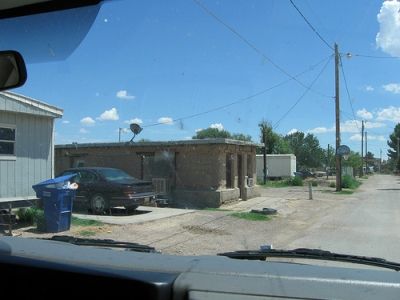
Publisher:
Bonnie King
CONTACT:
Newsroom@Salem-news.com
Advertising:
Adsales@Salem-news.com

~Truth~
~Justice~
~Peace~
TJP
Jun-02-2010 01:42

 TweetFollow @OregonNews
TweetFollow @OregonNews
Colonias to Get Centennial Boost
Kent Paterson Special to Salem-News.comBordering Mexico, Dona Ana County hosts 37 federally-designated colonias with a combined population of about 100,000 people.
 Pigeon Dreams photo by fruup, Webshots Courtesy: OPERATION NO GANGS Dona County News |
(LAS CRUCES, N.M.) - Colonias to Get Centennial Boost
New Mexico state Senator Mary Kay Papen has taken many a memorable truck ride on the bumpy roads of the numerous communities in her district called colonias. The Dona Ana County lawmaker says she even once donned work boots to wade through a street where sewage was spilling onto the surface.
“Very deplorable conditions,” Papen recalls.
Papen, however, is among many local leaders who are upbeat about the passage of a new law this year, the Colonias Infrastructure Act, which supporters maintain will lead to better infrastructure and basic services in underdeveloped, low-income rural and semi-rural communities classified by the federal government as colonias.
Co-sponsored by Papen and passed by the New Mexico State Legislature earlier this year, the Colonias Infrastructure Act earmarks an annual state appropriation from severance monies for road, wastewater and other infrastructure projects. Depending on future state income flows, an estimated $10 million could be available for such needs every year.
“We might be able to double that amount or better,” says the Dona Ana County Democrat, stressing that state funds could be matched by federal and other dollars.

For the first time, a reliable state-generated funding mechanism will exist to fund colonia infrastructure projects and not force advocates to periodically trek to Santa Fe with “hat in hand,” says Jess Williams, Dona Ana County’s public information officer.
The new revenue stream is expected to kick-in in 2012, the 100th anniversary of New Mexico’s statehood.
Dona Ana County Commissioner Oscar Vasquez Butler calls the act a “landmark” piece of legislation and the “first of a kind in our state and in our nation.” He says the legislative action was notable during a difficult fiscal year when lawmakers were considering cutbacks in capital outlays.
Bordering Mexico, Dona Ana County hosts 37 federally-designated colonias with a combined population of about 100,000 people, Vasquez Butler says. “As soon as you are outside (Las Cruces) you are in a colonia,” says the elected official whose district encompasses 25 colonias.
Colonias: The Old and the New, the Big and the Little
Thrice the size of Rhode Island, Dona Ana County is a study in contrasts. Home of New Mexico State University, it also embraces White Sands Missile Range and nudges the planned Spaceport America, a state-supported but privately-owned business that will specialize in sending wealthy tourists spiraling into the heavens.
Yet even as the earth movers and highway work crews cut an expanded Interstate 10 south to El Paso and the maquiladora zone of Ciudad Juarez, 1,500 miles of unpaved roads make up more than 60 percent of the county’s total road system, according to the Dona Ana County Health and Human Services Department.
In a throwback to an earlier era, some colonia children walk long distances to school, and emergency health needs can present serious challenges to people living in isolated zones. Fully one-third of Dona Ana County’s population is considered medically indigent, according to official numbers.
Prone to flash flooding during the summer monsoons, Dona Ana County has an estimated $600 million in unmet drainage improvement needs, Williams says.
Historically, wide expanses of New Mexico including Native American reservations and the Hispano villages located in the northern section of the state have endured conditions very similar to colonias in Dona Ana County and southern New Mexico. Overlooking Albuquerque, 400 or so families live in Pajarito Mesa which, for all intents and purposes, is a colonia.
Mass media have sometimes portrayed colonias as Third World slums creeping into the United States. But the rural and semi-rural communities provide a foothold to hundreds of thousands of people who are trying to achieve property ownership, raise families and live out their own version of the American Dream.
Also challenging a media stereotype, Dona Ana County’s colonias actually include historic communities which were founded during the 19th centuries, as well as the newer settlements that grew during and after the 1980s when booms in the dairy and labor-intensive agricultural industries attracted a new wave of mainly Mexican immigrant residents.
Many workers obtained legal residency thanks to the 1986 Immigration Reform and Control Act, and set down roots in southern New Mexico.
 ,Colonia Berino adobe, Doña Ana County Courtesy: Aquistbe on Flickr |
Unfortunately, state Senator Papen says, some of the newer settlements were built on illegally sub-divided land and the new property owners not given full disclosure about their real prospects for utility and other services.
According to a 2001 report by US Department of Housing and Urban Development officials Angela Donelson and Esperanza Holguin, an estimated 70,000 people, or five percent of the state’s entire population, resided in New Mexico’s colonias by 1990.
Neglected in the funding shuffle over the years, historic rural communities like Dona Ana now potentially benefit from a colonias designation which makes them eligible for targeted federal and state funding.
At a 2002 colloquium in Austin, the University of Texas’ Mona Koerner contended that the availability of federally-funded Community Development Block Grants managed by the New Mexico Department of Finance and Administration gave places like Catron County, an isolated entity far from the border region, a financial incentive to declare themselves colonias in order to be eligible for sorely-needed infrastructure funding. Statewide, 138 designated colonias were reported in 2000, according to Koerner.
The population of colonias varies considerably, ranging from the several dozen or so people who live in Milagro near Hatch to the estimated 15,000 residents of Sunland Park, an incorporated city with a local government, large race-track and casino and small amusement park.
A New Colonias Culture Although recent Mexican immigrants predominate in many colonias, others are very ethnically mixed. They include Mexican-American families whose presence on the land goes back generations, as well as newcomers like Anglo retirees who seek an affordable life-style in a hospitable climate. South of Las Cruces, the colonia of Vado was a historically African-American town founded during the early years of the last century.
Dr. Gina Nunez-Mchiri, professor of anthropology at the University of Texas-El Paso knows the northern Dona Ana County colonias very well. The daughter of a migrant farmworker family, Nunez-Mchiri’s once lived seasonally in Hatch when the local lettuce harvest was in full gear. Years later, Nunez-Mchiri returned as a census worker. Finally, she devoted her doctoral thesis to the histories and environmental issues of Hatch Valley colonias.
While ethnic and class tensions punctuate colonias, Nunez-Mchiri says, a certain degree of "cultural fusion,” especially between Mexican-American and Mexican immigrant families, is helping to revitalize the region.
Inter-marriage, culinary mixing, the blending of English, old New Mexican Spanish and northern Mexican Spanish into a kind of regional linguistic stew, and the cross-over of Country and northern Mexican music all form elements of a cultural dynamism the scholar says she has detected.
“When we talk about New Mexico, it is always about the north-Santa Fe, Taos, the indigenous communities on the reservations, Nunez-Mchiri says, “but there is a lot of culture in the southern part of New Mexico, too.”
In both her formal and informal observations, Nunez-Mchiri says she’s been witness to interesting scenes: “I think the most extraordinary thing I’ve seen is when there is a basketball or football game and you see the children of farmers, the children of farmworkers and the children of dairy workers, the people who are working formally and informally, all playing together. I’ve seen families, some wearing boots, others with Wranglers, others with tennis shoes, others with Texan hats and others with their baseball caps.”
A Political Milestone in Community Development
The 2010 Colonias Infrastructure Act is perhaps a belated official recognition of the importance and permanence of colonias. Moreover, it is also a culmination of sorts of decades of grassroots organizing campaigns. Beginning in the 1980s, Las Cruces’ Roman Catholic Diocese and the late Carlos Coral of the church’s social justice ministry emerged as early leaders in making the colonias a public policy issue. In 1994 a spin-off organization, the Las Cruces-based Colonias Development Council, was born. The non-profit group has since conducted countless organizing campaigns in numerous colonias.
In response to community concerns, the Dona Ana County Commission launched the Colonias Initiative in 2003. Since then, the County has received more than $15 million in state funding for infrastructure improvements, according to the Dona Ana County Health and Human Services Department, which oversees the initiative. Leveraged with additional federal dollars, funds have been spent on road paving, wastewater and other infrastructure projects.
“Its’ a complete remake of Dona Ana County at this point,” Vasquez Butler contends.
“I do think a quality of life is beginning to happen in the area,” Papen says.
Veronica Carmona, lead organizer for the Colonias Development Council, agrees that significant improvements in delivering electricity and paving roads have been made in Dona Ana County during the past few years. Carmona says colonia leaders are pleased with the new state law, but implementation of the act will depend on economic and political factors.
“The expectation in the communities is that they aren’t going to have to wait 20 years for paving a street or sewage or to resolve the problems of flooding that exist,” Carmona says. “The project has a long way to go in being developed, but the important thing is that the money is approved.”
The new law creates a seven-person Colonias Infrastructure Board made up of members appointed by both the executive branch of state government and legislative leaders. Principally from southern New Mexico, five non-voting members will advise the board.
Vasquez Butler argues that much fine-tuning remains to be done to shape the decision-making process which will guide the Board in prioritizing specific projects in individual communities. Ample public transparency and minimal backroom deal-making will be the keys to success, he says.
Dona Ana County’s Williams says the new colonias law is an obvious boost to his home, but other places within the geographic scope of the act, up to 150 miles north of the US-Mexico border, will also compete for funding.
“Of course, we recognize that we are not the only county with colonias and won’t get the full pot,” Williams adds. For Nunez-Mchiri, the Colonia Infrastructure Act represents one important step in politically validating communities marginalized from the mainstream. But the expected infrastructure improvements that will flow from new law, she adds, are but one component of a broader investment needed in education, economic development, environmental quality and community well-being. The border-area researcher remembers a conversation she had with a woman during the census count a decade ago. “'How nice it is that you all came to count us,'” Nunez-Mchiri recalls the woman saying. “'Because now you all know we exist.'”
-Kent Paterson
- This story was a special contribution to Frontera NorteSur’s New Mexico Centennial series.
- Support for the piece was made possible in part by the McCune Charitable Foundation and the New Mexico Humanities Council.
- Frontera NorteSur (FNS): on-line, U.S.-Mexico border news Center for Latin American and Border Studies New Mexico State University Las Cruces, New Mexico
Articles for June 1, 2010 | Articles for June 2, 2010 | Articles for June 3, 2010
Quick Links
DINING
Willamette UniversityGoudy Commons Cafe
Dine on the Queen
Willamette Queen Sternwheeler
MUST SEE SALEM
Oregon Capitol ToursCapitol History Gateway
Willamette River Ride
Willamette Queen Sternwheeler
Historic Home Tours:
Deepwood Museum
The Bush House
Gaiety Hollow Garden
AUCTIONS - APPRAISALS
Auction Masters & AppraisalsCONSTRUCTION SERVICES
Roofing and ContractingSheridan, Ore.
ONLINE SHOPPING
Special Occasion DressesAdvertise with Salem-News
Contact:AdSales@Salem-News.com

googlec507860f6901db00.html



Terms of Service | Privacy Policy

All comments and messages are approved by people and self promotional links or unacceptable comments are denied.
[Return to Top]
©2025 Salem-News.com. All opinions expressed in this article are those of the author and do not necessarily reflect those of Salem-News.com.